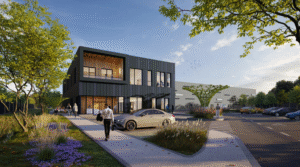Much attention has recently been given to rising office vacancy rates, but there’s another segment facing increasing challenges: street-level commercial spaces. Our leading office and retail real estate agent, Aira Veelmaa, provides further insight.
At first glance, it might seem that such spaces are in short supply due to frequent demand. However, there’s a critical caveat: the demand is focused on spaces that are highly visible, easily accessible, located on busy streets, and offer convenient parking. These criteria are mostly met in the city center or along major thoroughfares—locations where supply is limited and turnover is rare, as prime spots tend to retain tenants. If a retail space is located downtown but lacks visibility or ease of access, finding a suitable tenant becomes significantly more difficult. These types of properties tend to see higher tenant turnover. The situation is even more challenging outside the city center, where even brand-new, attractive retail spaces can sit vacant for extended periods due to insufficient demand.
New residential developments are continuously bringing additional retail units to market, as most buildings are required to include commercial space on the ground floor. This has led to a clear oversupply. Even in well-designed mixed-use developments in good locations, filling these retail units can be a struggle—let alone in less desirable areas. Businesses located outside the city center face a difficult task attracting enough foot traffic. A single residential block can only support a limited number of neighborhood-oriented businesses, otherwise there simply aren’t enough customers to go around.
This raises the question: what types of businesses are even suitable for retail units in residential neighborhoods? Much of today’s retail activity has consolidated into shopping centers, where people can comfortably browse regardless of the weather and where synergy between businesses draws in more customers. Retailers not operating in malls and not reliant on high foot traffic often prioritize online sales, requiring only modest office or showroom spaces that don’t need to be located on expensive high-visibility retail streets. Likewise, small cafés, bakeries, and service providers—which might conceptually fit into residential areas—often struggle to generate enough revenue in peripheral locations to cover even the relatively low rents, especially compared to high construction and sales prices.
This leads to another issue: developers find it increasingly difficult to sell these commercial units, as they are not attractive to investors. Vacancy risk is high, and even if a tenant is found, current rental levels are often insufficient to ensure the expected returns. Potential end-users who might have interest often lack the capacity to purchase these units at the developer’s price point.
The regulation requiring retail units on the ground floor of apartment buildings has resulted in an increasing number of empty street-level spaces in otherwise attractive new residential areas. Multiple long-vacant units within the same district can also deter potential buyers or tenants, further exacerbating the issue.
If authorities continue to require commercial units in new developments, the supply will only keep growing, and the problem will deepen. It’s time to consider alternative solutions—perhaps assigning a different function to ground-floor spaces and scaling back the volume of commercial premises. Admittedly, a ground floor with display windows looks more appealing than a garage, but from a functionality perspective, it may be more practical in some cases to use the space for parking instead. Our talented architects are certainly capable of designing aesthetically pleasing and engaging parking levels that integrate well into the urban environment—far more effectively than row after row of long-vacant retail units.




